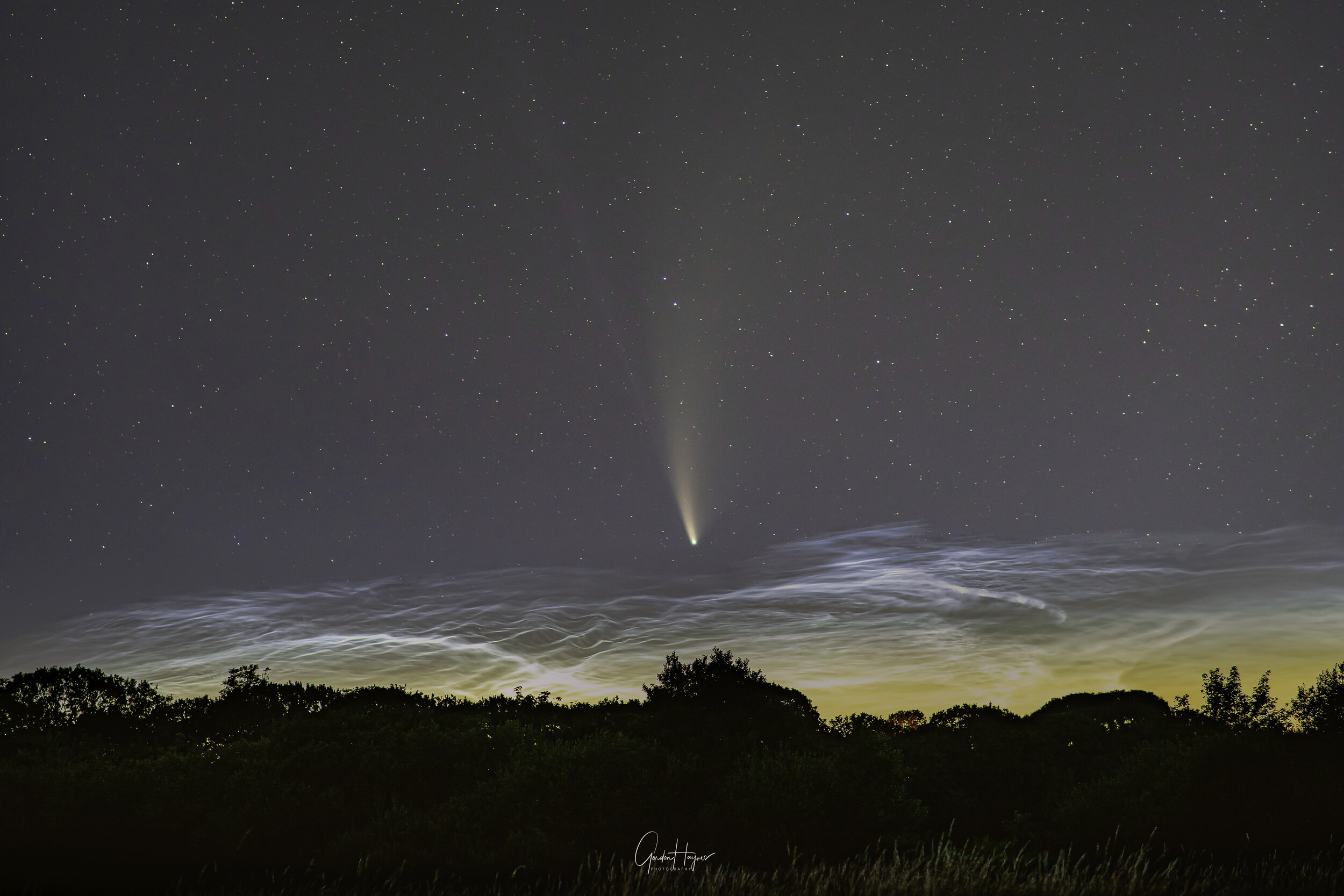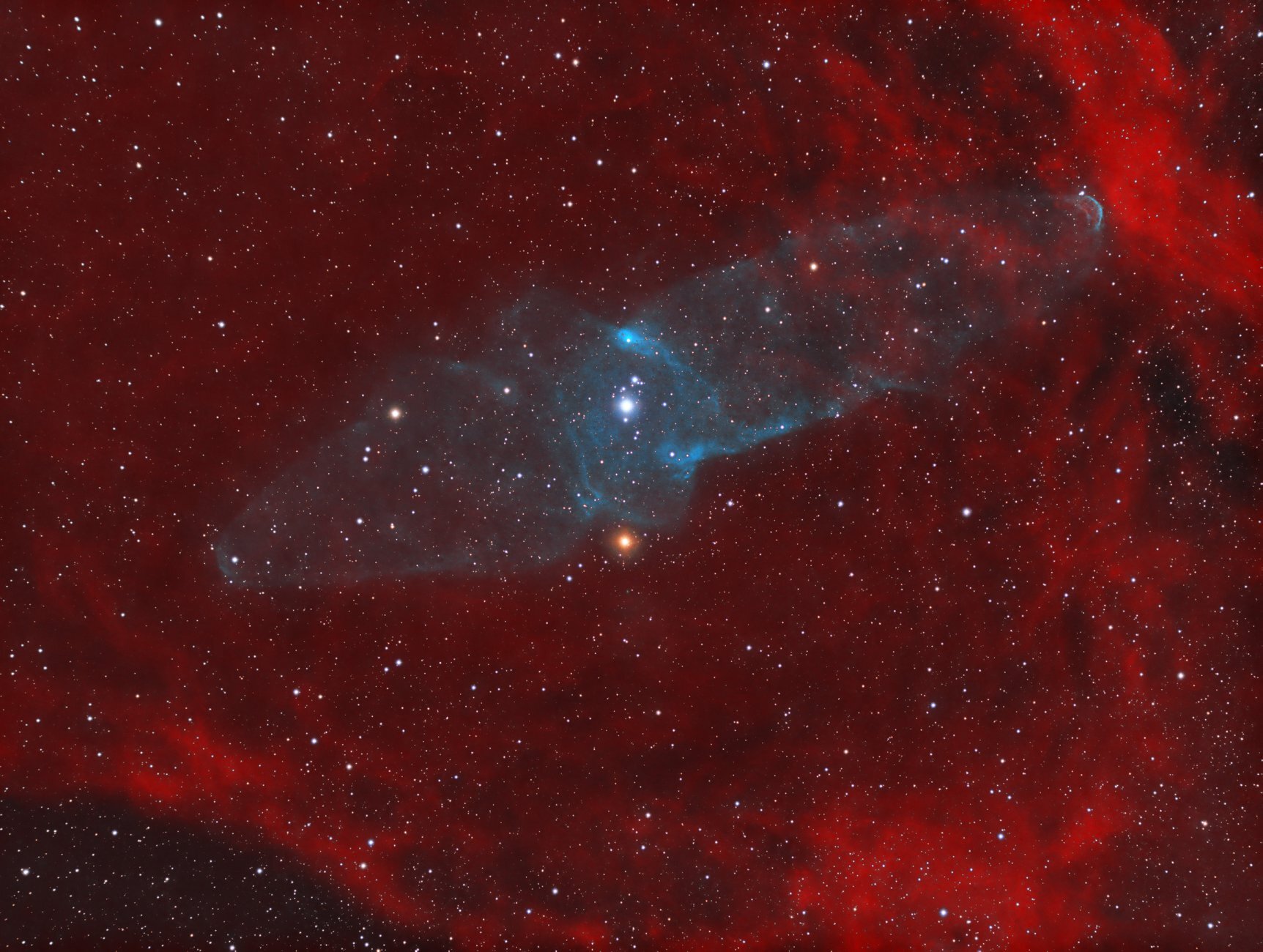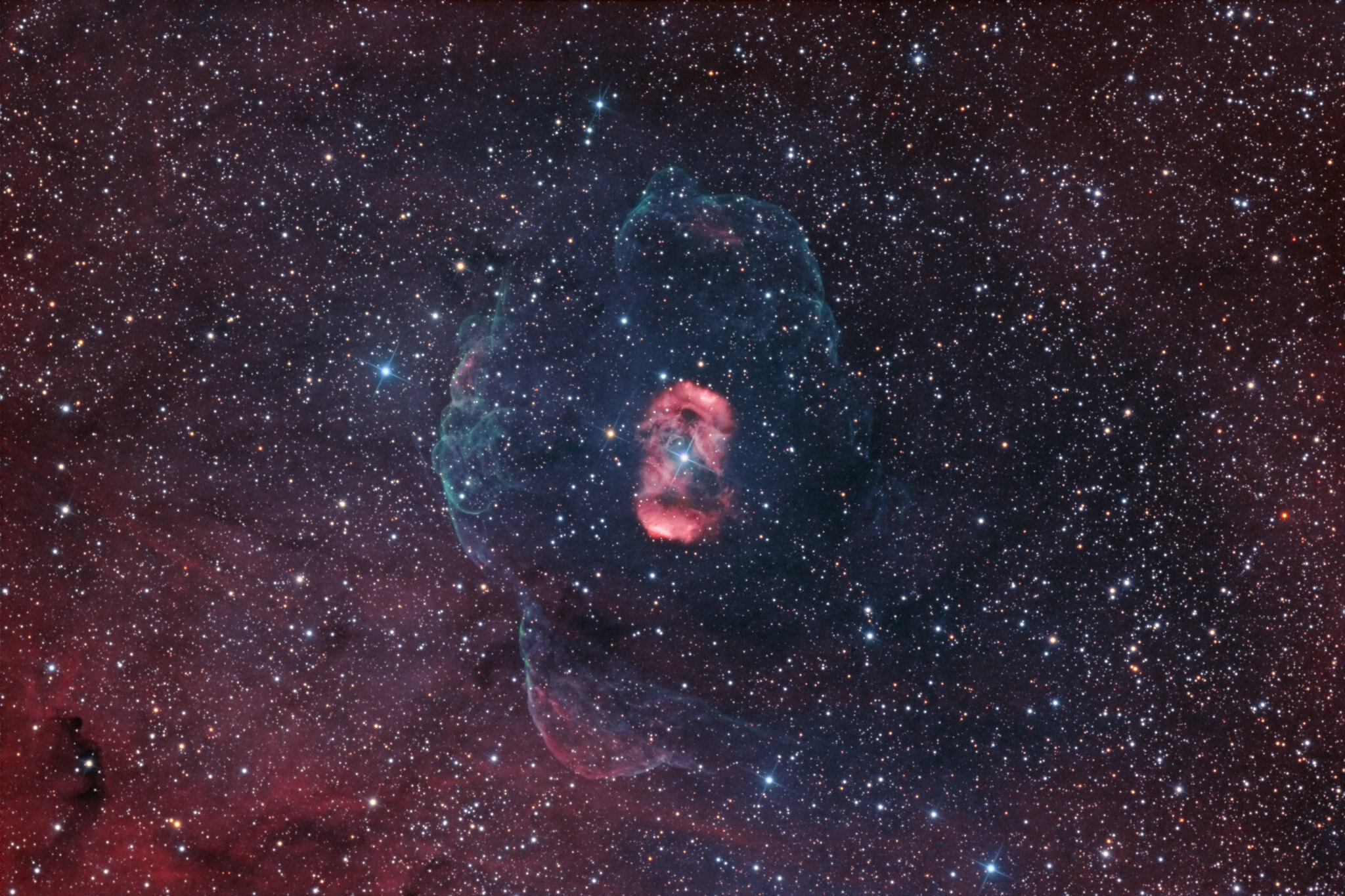
AAPOD2 Image Archives
Strottner-Drechsler 56 (StDr56) Goblet of Fire nebula
Image Description and Details :
StDr 56 / Goblet of Fire nebula (c) Robert Pölzl & Marcel Drechsler & Xavier Srottner. This probable new planetary nebula was discovered by my colleague Xavier Strottner and me in January 2020. If the candidate is confirmed as a true planetary nebula, it will be the first planetary nebula ever discovered in the constellation Triangulum (Triangle).
Photo: StDr56 was photographed by the Austrian Robert Pölzl with a total exposure of 59 hours.
Image processing: Marcel DrechslerAt the center of the PN candidate is a potential white dwarf with a surface temperature of 35542 Kelvin and a distance of about 1130 light years to Earth. With an extension of 44 x 36 arc minutes, StDr56 is not only the largest probable PN in the region, but in the night sky it covers more than half of the area of the famous Triangulum Galaxy M33, which is located only a few degrees from Strottner-Drechsler 56.
Robert Pölzl collected 90 hours of exposure time in 21 nights from July to November 2020.Out of these 90 hours, 30 hours had to be sorted out because of minimal cirrus and dew - leaving 59 hours at the end.Coordinates: 02:07:17.41 +30:05:11.90 (J2000)Name: Strottner-Drechsler 56, StDr56, PN-G: 141.8-29.9Data:58 x 30 min. H-alpha41 x 30 min [OIII].28 x 10 min. RGB eachDate: 31.7.2020 - 18.11.2020Location: Observatory Hirschegg-ÖsterreichOptics: Lacerta Newton 10" f/4Camera: Moravian G2 8300 at -30° - Baader filter
Copyright Information: Robert Pölzl & Marcel Drechsler & Xavier Srottner
Mars Approach 2020
Mars sequence for 2020 so far! Mars has spent the year approaching Earth, it's now closer than it will be for the next decade. Less dust than in 2018, it's more about watching spring headed into summer for Mars' southern hemisphere. Images go from February to the end of September.
All images Celestron C14 & ZWO ASI290MM camera.
Copyright: Andy Casely
A Flying Bat (Sh2-129)
A Flying Bat (Sh2-129) with a Squid (Ou4) Inside?
I have been wanting to try this deep sky object for two years. It is quit interesting two objects for the prices of one. In reality I only have a portion of Sh2-129, the Flying Bat Nebula, which is a huge region of hydrogen gas represented by the red color captured with the Hydrogen gas filter (Ha). Located in Cepheus approximately 2,300 light-years away, Sh2-129 is a faint emission nebula and has been known about since at least the 1950's as a neighbor to IC 1396, the Elephant Trunk Nebula. I must admit, even after looking at widefield images of the Sh2-129, I see no resemblance to a Flying Bat. The Squid on the other hand does resemble a squid with it tentacles rapped up. The Squid Nebula (Ou4) is a relatively new discovery from 2011 by French astro-imager Nicolas Outters. It consists doubly ionized oxygen which gives it the green-blue color in contrast to the hydrogen. It may seem odd that this was not found until 2011 but there is a really good reason, it is really dim. I was taking 5-minute subs and while there was some nebulosity in the Ha region, there was nothing in OIII, not even a hint. If you are the type that likes to complete an object in one night, then this would not be a good choice.
Originally the Ou4 was thought to be a Planetary Nebula unrelated to Sh2-129, however, recent studies suggest it is within Sh2-129 and is bipolar outflow from a triple star system. The bright blue star in the center is the believed to be the source.
I wanted to get at least 15-hours and was able to get this done quicker than I anticipated due to unexpected clear weather. It worked out really well as we had a succession of clear nights when I was painting my garage floor anyway so conveniently left everything set up and just put a cover over it. This was one of the hardest things I have processed due the conflicting things going on. The Ha data was really strong and came out very well with hardly any processing. Not surprisingly, the OIII was very difficult to bring out and a lot of time was spent on it. StarNet was used to make separate starless Ha and OIII images which were combined to make a starless HOO image. The last part of the process was merging the RGB stars with the HOO starless image. This turned out be more difficult as the method I normally use for combining RGB stars with narrowband images didn't work well with the starless image so I used alternative method in PS described by Trevor Jones.
Camera: ZWO ASI1600MM-Pro
Telescope: Astro-Tech AT115EDT 115mm Refractor Telescope
Focal Reducer: AstroTech Field Flatterner/Focal Reducer
Mount: Orion Atlas Pro
Filter Wheel: ZWO EFW 8 x 1.25"
Filter: ZWO Ha, OIII, R, G, B
Focuser: ZWO EAF
Autoguiding: ASI120 Mini attached to an Agena 50mm Guide Scope/ZWO 60mm Guidescope
Exposure: Ha 150 x 300s, OIII 165 x 300s, R 45 x 60s, G 29 x 60s, B 29 x 60s
Processing: APT, NINA, PixInsight, Photoshop.
Copyright: Kurt Zeppetello
ISS over Santiago -Chile
Both images were captured after sunset from videos recorded, while manually guiding through the Telrad finder of my 11" f/5 dobsonian telescope. I reviewed the videos and extracted the useful frames with PIPP, then I stacked the 10 to 15 best frames in Autostakkert 3. Finally I used Registax 6 to sharpen a bit the stacked image.
For the second image I used a 2x barlow for a better image scale. The same processing procedure was applied to get the final image.
Copyright: Rodrigo Carvajal Aravena
IC2220 - Toby Jug Nebula
Here is the Toby Jug Nebula imaged with the CDK17 in Chile (Obstech El Sauce).
While there are many images of this out there, few feature the outer Ha halo that was only recently discovered (I dont know how recent or who by).
The Ha is extremely faint and it took 21 hours at bin 2x2 to reveal what is shown here.
Sharpless 171
Acquired in suburban backyard Magnolia, TX USA, June 28-October 23, 2019
Equipment: Sky-Watcher Esprit 150mm ED APO, FLI ML16200, Astro-Physics 1100GTO
Chroma Ha 3nm, Chroma OIII 3nm, Chroma SII 3nm
Software: Sequence Generator Pro, PHD2, PixInsight
Resolution: 4402x3517
Integration: 59.2 hours
Ha: 78x900" -25C 1x1
OIII: 79x900" -25C 1x1
SII: 80x900" -25C 1x1
Pixel scale: 1.148 arcsec/pixel
Field radius: 0.898
Copyright: © John Renaud
NGC 6164
NGC 6164 has an appearance similar to what you would see in a planetary nebula. It has a gaseous shroud that surrounds the central star. These typically have shock-waves, and often highlight where they brighten showing where they are interacting with the interstellar medium.
The extensive outer halo would have to be my favorite part of this image. The outer halo is very dim and certainly proved to be a challenge to reveal it with all the tiny filaments with blue and teal highlights and a bit of red where Ha is present. There is a feature that I initially believed to be a light leak. On the left side of the image, there is what looks like a straight line. After looking through many images, it’s definitely real, and not a light leak.
NGC 6164 is 4,200 light-years away in the constellation of Ara. It is about 21 X 13 arc mins, at magnitude 11. It contains a very bright O-type star about 40 times as massive as our sun. The nebula in the center spans around 4 light-years and has an interesting bipolar symmetry, this is all framed nicely in the larger outer-shell, all set within a beautiful star-field.
Equipment Details: 10 Inch RCOS fl 9.1
Astro Physics AP-900 Mount
SBIG STL 11000m
FLI Filter Wheel
Astrodon Lum, Red, Green, Blue Filters
Baader Planetarium H-alpha 7nm Narrowband-Filter
Baader Planetarium OIII 8.5nm Narrowband-Filter
Baader Planetarium SII 8.0nm Narrowband-Filter
Exposures Details:
Lum 45X900 Bin 1
Red 15X900 Bin 1
Green 14X900 Bin 1
Blue 12X900 Bin 1
Ha 61X1800
OIII 113X1800
Total Time: 108.75 hours
Andromeda Clouds in HaRGB
Here is an image of Andromeda Clouds in HaRGB, with 23 hours of total exposure.
Captured during 6 nights of New Moon from Pioz, Guadalajara, Spain.
It is the biggest project I have done since I started doing astrophotography and it is an honor for me to be one of the few astrophotographers who have photographed these strange clouds in color.
You can see more information and photos in my section of the website:
https://aipastroimaging.com/m31-ha-clouds-hargb/
In full resolution:
This photo was taken with this setup:
Telescope: Takahashi FSQ106EDX (f/5)
Mount: Takahashi EM-400 Temma2
Camera: Atik 16200 (Kodak KAF16200)
Guider: Lunático EZG-60 + SXLodestar
Filters: Baader Ha 7nm, Baader LRGB
Focuser: RoboFocus Rev3.1
Date: November and December 2018
Place: Pioz, Guadalajara, España
Software: MaxIm DL + AstroMatic
Processing: PixInsight Core + Photoshop CC
Exposure: Ha: 80x900s bin2, RGB: 12x300s bin2.
Total: 23h
Copryright: Álvaro Ibáñez Pérez













